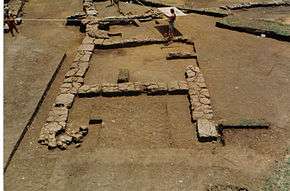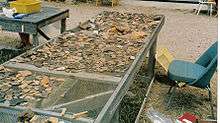Satricum
 Students at work at the archaeological site of Satricum in 1983. | |
 Shown within Lazio | |
| Alternate name | Le Ferriere |
|---|---|
| Location | Borgo Le Ferriere, Italy |
| Region | Lazio |
| Coordinates | 41°30′47.2608″N 12°45′18.2988″E / 41.513128000°N 12.755083000°E |
| Type | settlement |
| History | |
| Founded | sixth century BC |
| Cultures | Volscian; Roman Republic |
| Site notes | |
| Excavation dates | yes |
| Archaeologists | Antonio Nibby; Conrad M. Stibbe; M. Kleibrink; Marijke Gnade |
| Condition | ruined |
| Public access | yes |
Satricum (modern Le Ferriere), an ancient town of Latium, lay on the right bank of the Astura river some 60 kilometres (37 mi) SE of Rome in a low-lying region south of the Alban Hills, at the NW border of the Pontine Marshes. It was directly accessible from Rome via a road running roughly parallel to the Via Appia.
History
According to Livy, Satricum was an Alban colony, and a member of the Latin League of 499 BC. Ca. 488 BC it was taken by the Volsci.[1] It was several times won and lost by the Romans, and twice destroyed by fire. After 346 BC we hear of it only in connection with the temple of Mater Matuta.[2]
Identification and history of research
Antonio Nibby[3] mistakenly identified ancient Satricum with the low hill at Borgo Montello, then known as the Tenuta di Conca, surrounded by tufa cliffs, 1.5 km ESE of present-day Le Ferriere, on which were still scanty remains of walling in rectangular blocks of the same material. In 1896, the hill above Le Ferriere yielded remains of an archaic and early Classical sanctuary ascribed to Mater Matuta, during excavations begun under the direction of Prof. H. Graillot of the University of Bordeaux, member of the French School of Rome. After two weeks, this work was suspended by order of the Italian government, and then resumed under the supervision of Felice Barnabei,[4] Raniero Mengarelli, and A. Cozza. The objects discovered were brought to the Villa Giulia Museum at Rome.
After some cursory investigations during the 1950s, the site of Satricum was brought to light again in 1977, as a result of a concerted effort by the Italian authorities to rescue the antiquities in the Roman campagna that were acutely threatened by large-scale urbanisation and agricultural reform. The alarm was first made public by the exhibition Civiltà del Lazio primitivo at Rome (1976).[5] As a result, the Royal Dutch Institute at Rome was invited by the Comitato per l'Archeologia laziale to participate in a rescue project and to ascertain the state of preservation of the site.[6]
Since 1977, a comprehensive research program at the site has been carried out through annual excavation and study campaigns. This concerned, first of all, activities by the Royal Dutch Institute at Rome (C. M. Stibbe),[7] later joined by the Universities of Groningen (prof. M. Kleibrink) and Nijmegen (prof. J. de Waele). As of 1990, the project is being executed by the University of Amsterdam alone, under the direction of prof. Marijke Gnade.
Results

Several inscriptions bearing the name of Mater Matuta have now made undisputed the identification of the city on and around the acropolis directly to the south of today's Le Ferriere with ancient Satricum. There remains, however, some discussion on the equation, proposed by C.M. Stibbe, of Satricum with the legendary city of Suessa Pometia.
The sanctuary on top op the acropolis was re-excavated in 1978-1981. Metrological analyses by Prof. J. de Waele, published in 1981[8] convincingly demonstrated a succession of three building phases dated from the late 7th to the early 5th century BC. Further investigations in the subsoil showed a particularly large, rather isolated hut to have preceded them, possibly with a religious function. Evidence for a large number of other huts of various shapes testify to a concentrated use of the acropolis during Latial periods II-IV (1000 - 580 BC).
The three temples succeeding one another are characterized by Etrusco-Ionian, Campanian, and central-Italic traditions, respectively, in material, technology, and artistic background, evidencing the character of Satricum as a true crossroads of regionally competing, or successive, cultures. The discovery, in 1977, of the Lapis Satricanus re-used in the foundations of the last temple and bore the name Publius Valerius (possibly to be identified with Publius Valerius Poplicola) perhaps confirms to the political connections between Satricum and Republican Rome.[9]
The Archaic Period at Satricum is evidenced by a number of large courtyard buildings on and at the foot of the acropolis. To the NE, a network of large roads, amongst which a "Sacra Via", in combination with a dense urban build-up have been traced, documenting various phases from the 6th to 4th century BC.
Among the more surprising recent (1981) findings is a large necropolis dated to the 5th and 4th century BC, within the agger in the SW corner of the Archaic city. The material culture of the populace buried here, yielding i.a. a rare inscription on a lead miniature axe bearing the inscription iukus|ko|efiei, shows strong connections with indigenous, Volscian traditions best known from the interior regions of the Apennine Peninsula. In fact, the discovery corroborates the historical traditions of the Volscians conquering Satricum in 488 BC. Tombs of this kind have successively been found both on the very top of the acropolis and intermixed with the remains of roads in the NW city area.
In addition to ongoing fieldwork, the storerooms and archives of the Villa Giulia Museum have gradually become accessible for advanced research. Thus the precise details are now known of the circumstances that led to the first excavation campaign by Graillot, the Italian government's intervention, and the subsequent neglect of the Satricum objects in the Villa Giulia. In addition, many object categories have now been properly studied and published (finds from the Archaic Votive Deposit, from the Orientalising and Archaic necropolises to the NE of the city, and the architectural terracottas of the sanctuary).
Bibliography
Monographs, dissertations, congresses
- C.M. Stibbe et al., Lapis Satricanus. Archaeological, Epigraphical, Linguistic and Historical Aspects of the New Inscription from Satricum, The Hague 1980
- M. Maaskant-Kleibrink et al., Settlement Excavations at Borgo Le Ferriere (“Satricum”)I-II, Groningen 1987 and 1992
- R.R. Knoop, Antefixa Satricana. Sixth-century Architectural Terracottas from the Sanctuary of Mater Matuta at Satricum (Le Ferriere), Wolfsboro/Assen 1987
- M. Gnade, The Southwest Necropolis of Satricum. Excavations 1981-1986, Amsterdam 1992
- D.J. Waarsenburg, The Northwest Necropolis of Satricum. An Iron Age Cemetery in Latium Vetus, Amsterdam 1995
- B. Ginge, Excavations at Satricum, Borgo Le Ferriere, 1907-1910: Northwest Necropolis, Southwest Sanctuary and Acropolis, Amsterdam 1996
- P.S. Lulof, The Ridge-Pole Statues from the Late Archaic Temple at Satricum (Le Ferriere), Amsterdam 1996
- J.W. Bouma, Religio Votiva: the Archaeology of Latial Votive Religion, Groningen 1996
- A.J. Nijboer, From Household Production to Workshops. Archaeological Evidence for Economic Transformations, Pre-Monetary Exchange and Urbanisation in Central Italy from 800 to 400 BC, Groningen 1998
- M. Gnade, Satricum in the Post-Archaic Period. A case study of the interpretation of archaeological remains as indicators of ethno-cultural identity, Leuven 2002
- Proceedings of the Satricum Centennial Congress (1887-1997) in: Mededelingen van het Nederlands Instituut te Rome/Antiquity, LVI (1997) 1-204
- Lemma "Satricum" in the Enciclopedia dell'Arte Antica, Classica e Orientale, Suppl. II.V (1997) 177-180
Excavation updates
Preliminary reports have been appearing frequently since 1978 in the scholarly periodicals Archeologia Laziale, Bulletin Vereniging Antieke Beschaving, Mededelingen van het Nederlands Instituut te Rome and Lazio & Sabina.
Popular books by the Netherlands Study Center for Latium
- B. Heldring, Satricum. Een stad in Latium / Satricum. Una città del Lazio / Satricum. A Town in Latium, Hollandse Rading 1985 (rev. 1989) /Latina 1987, Meppel 1989
- C. Stibbe, Satricum en de Volsken / Satricum ed i Volsci, Hollandse Rading 1985 / Meppel 1991
- H. Versnel, Satricum en Rome. De inscriptie van Satricum en de vroeg Romeinse geschiedenis / Satricum e Roma. L'iscrizione di Satricum e la storia romana arcaica, Hollandse Rading 1985 / Meppel 1990
- D. Waarsenburg, Satricum, Kroniek van een opgravìng / Satricum. Cronaca di uno scavo. Ricerche archeologiche alla fine dell'Ottocento, Tonden 1996 / Rome 1998
- P.S. Lulof, R.R. Knoop, Satricum. Tempels en daken Meppel 1998
Exhibitions
- Satricum una città Latina, Exhibition catalogue Latina 1982, Florence 1982
- Nieuw licht op een oude stad. Italiaanse en Nederlandse opgravingen in Satricum, Exhibition catalogue Leiden/Nijmegen 1985, The Hague/Rome 1985
- Area sacra di Satricum tra scavo e restituzione, Exhibition catalogue Albano Laziale 1985, Rome 1985
- Currently, a permanent site museum is being prepared as part of the provincial "Parco Satricum" project, to be inaugurated in late 2007, illustrating the history of the site and of the archaeological research: M. Gnade (red.), Satricum: Trenta anni di scavi olandesi (catalogue exhibition Le Ferriere - Latina 2007), Leuven: Peeters, ISBN 978-90-78863-14-4
Notes
- ↑ Livy, Ab urbe condita, 2.39
- ↑ Mauro Rubini (2002). Satricum in the Post-archaic Period: A Case Study of the Interpretation of Archaeological Remains as Indicators of Ethno-cultural Identity. Isd. ISBN 978-90-429-1193-2.
- ↑ Analisi della carta dei dintorni di Roma, Rome, 1848, iii.64.
- ↑ http://www.treccani.it/enciclopedia/felice-barnabei_(Dizionario-Biografico)/
- ↑ Maria Ornella Acanfora (1976). Civiltà del Lazio primitivo: esposizion , Palazzo delle esposizioni, Roma, 1976. Multigrafica.
- ↑ Patricia S. Lulof (1996). The Ridge-pole Statues from the Late Archaic Temple at Satricum. Thesis. ISBN 978-90-5170-355-9.
- ↑ nl:Conrad M. Stibbe
- ↑ Mededelingen Nederlands Instituut Rome.
- ↑ Gnade, M. 2012. "Lapis Satricanus." The Encyclopedia of Ancient History DOI: 10.1002/9781444338386.wbeah20080
External links
- Satricum Project website of University of Amsterdam
- (Dutch) website of Riemer Knoop, on architectural terracottas
- website of Groningen University Laboratory for Conservation & Material Studies
 This article incorporates text from a publication now in the public domain: Chisholm, Hugh, ed. (1911). "article name needed". Encyclopædia Britannica (11th ed.). Cambridge University Press.
This article incorporates text from a publication now in the public domain: Chisholm, Hugh, ed. (1911). "article name needed". Encyclopædia Britannica (11th ed.). Cambridge University Press.
Coordinates: 41°30′47.2608″N 12°45′18.2988″E / 41.513128000°N 12.755083000°E
| Wikimedia Commons has media related to Satricum. |